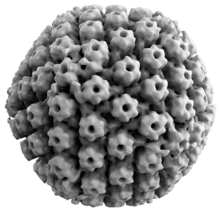Herpes simplex viruses
| Herpes simplex viruses | ||||||||||||||||||||
|---|---|---|---|---|---|---|---|---|---|---|---|---|---|---|---|---|---|---|---|---|

TEM image of the herpes simplex virus 1 |
||||||||||||||||||||
| Systematics | ||||||||||||||||||||
|
||||||||||||||||||||
| Taxonomic characteristics | ||||||||||||||||||||
|
||||||||||||||||||||
| Scientific name | ||||||||||||||||||||
| Human alphaherpesvirus 1, 2 | ||||||||||||||||||||
| Short name | ||||||||||||||||||||
| HSV-1 and HSV-2 | ||||||||||||||||||||
| Left | ||||||||||||||||||||
|
As Herpes simplex virus ( HSV ) refers to two closely related human pathogenic (to humans infecting) virus species: The human (alpha) Herpes Virus 1 (HSV-1) and 2 ( scientific human alpha herpes virus 1 or 2 ). The two species were originally classified as serotypes of the same species. They both belong (along with other non-human pathogenic species) to the genus Simplexvirus from the subfamily Alphaherpesvirinae in the family Herpesviridae .
The herpes simplex viruses cause very different diseases of the herpes simplex , including the so-called mouth rot in small children. However, the most common symptoms of infection with these viruses are cold sores ( herpes labialis ) and genital herpes ( genital herpes ). The herpes neonatorum in the newborn and the herpes simplex encephalitis particularly in immunosuppressed people represent life-threatening complications.
morphology
The herpes simplex viruses consist of an icosahedral capsid about 100 to 110 nm in diameter . This is encased by about 20 tegument proteins and surrounded by an outer virus envelope ; the complete virions are about 140 to 180 nm in size (very variable depending on the examination method). The capsid consists of 162 capsomeres, 150 of which are arranged in hexagonal symmetry (hexons), twelve in pentagonal symmetry (pentons). The hexons consist of six molecules of the main capsid protein VP5 (155 kDa ) and six molecules of the vertex protein VP26; these twelve protein molecules of the hexons are arranged around a central pore. Three hexons each are combined in a triangular symmetry into which the structural proteins VP19c and VP23 are also integrated. The pentons consist of five molecules of VP5 and are each located at the twelve corners of the icosahedral symmetry. Two other structural proteins are contained in the capsid in small quantities: VP24, which has the properties of a protease and is important for the maturation of the capsid, and the gene product U L 6 , which is unclear in its function .
The tegument proteins covering the capsid contain important proteins for gene regulation of the infected cell and for the initiation of viral replication, the function of which has not yet been characterized. VP16, which is also called αTIF ( alpha-trans-inducing factor ), and a virion-associated factor U L 41, which can prevent cellular translation ( host shut-off ), are known. The tegument proteins also include the regulatory immediate early proteins (IE) ICP4 and ICP0 and the large subunit of the viral ribonucleotide reductase RR1.
The viral envelope of the herpes simplex virus contains at least ten different viral proteins (predominantly glycoproteins) that are embedded in a cellular lipid membrane. The coat protein gG-U S 4 shows most of the differences between the species HSV-1 and HSV-2 and is responsible for their different serological properties. At least four envelope proteins (gD-U S 6, gL-U L 1, gH-U L 22 and gB-U L 26) mediate the penetration of the virus into the cell. The sequence of the gB proteins is conserved in a large number of members of the Herpesviridae . The envelope proteins US7-gI and US8-gE form a heterodimer that mediates the direct spread of viruses between cells and can bind the Fc part of IgG antibodies .
Genome
The genome consists of a 152 kb linear double-stranded DNA. The correspondence between the nucleotide sequences of HSV-1 and HSV-2 is more than 99% in most gene regions and about 85% in the entire sequence. The deviations mainly concern genes that are involved in the control of viral gene expression or some viral envelope proteins. During virus replication, the linear DNA is closed to form a ring ( cccDNA ) and can persist in this form in the cell nucleus. The genome codes for more than 100 gene products with over 80 open reading frames .
Systematics
- Family Herpesviridae
-
- Subfamily Alphaherpesvirinae
-
- Genus simplex virus
- Species herpes simplex virus 1 (HSV-1) or human herpes virus 1 (HHV-1) s. Human alphaherpesvirus 1
- Species herpes simplex virus 2 (HSV-2) or human herpes virus 2 (HHV-2), en. Human alphaherpesvirus 2
- Herpes B virus species . Macacine alphaherpesvirus 1 , obsolete Macacine herpesvirus 1 , Cercopithecines herpesvirus 1 (CeHV-1 or CHV-1), herpesvirus simiae
- Species Cercopithecine alphaherpesvirus 2 (not renamed)
...
swell
- CM Fauquet, MA Mayo et al .: Eighth Report of the International Committee on Taxonomy of Viruses . London, San Diego, 2005 ISBN 0-12-249951-4
- Allan Granoff, Robert G. Webster (Eds.): Encyclopedia of Virology . San Diego 1999, Volume 2, pp. 677ff ISBN 0-12-227030-4

